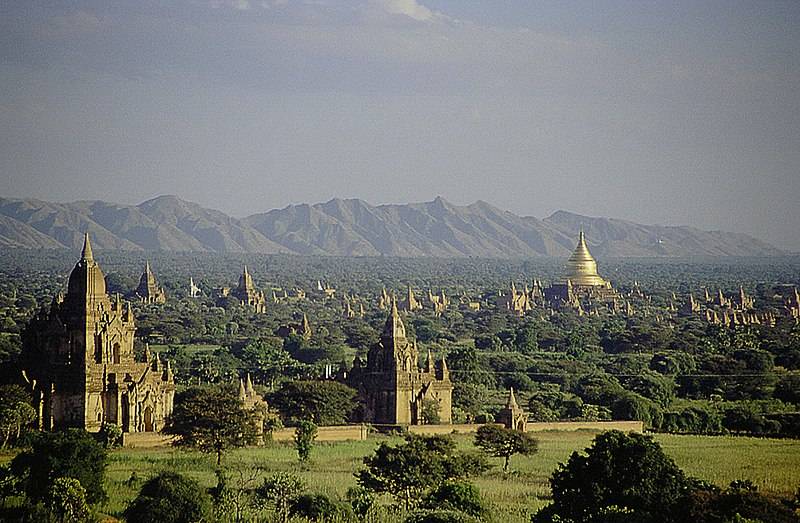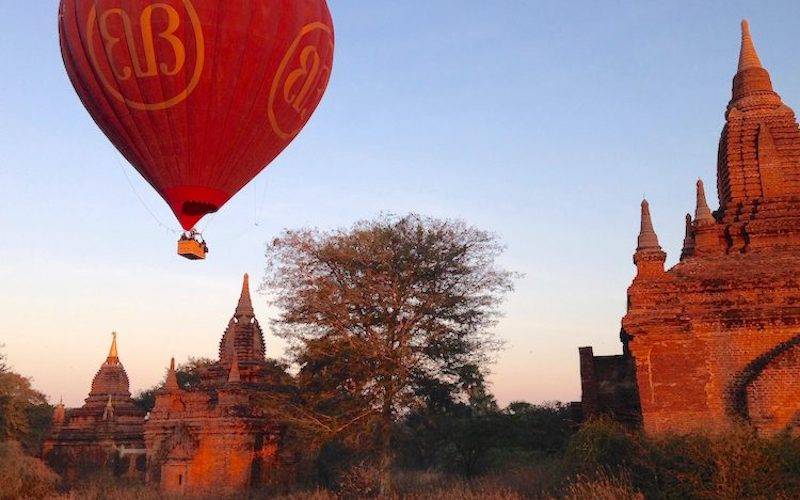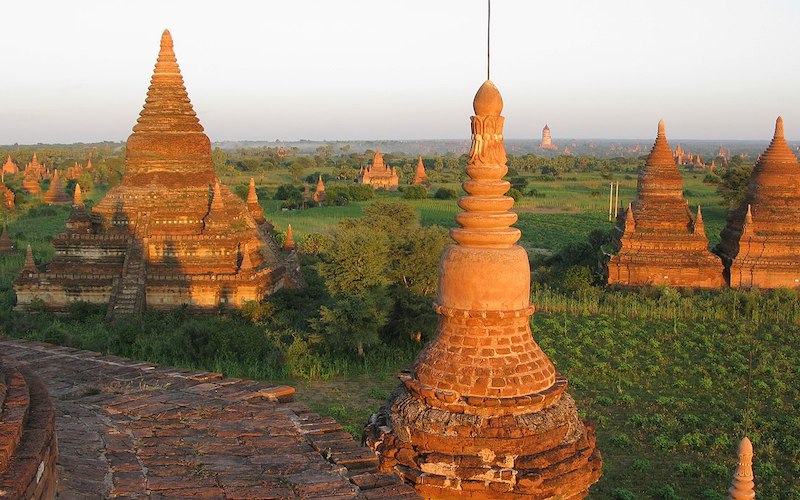I have to admit – I’m an absolute sucker for ancient Buddha parks. Southeast Asia has many fantastic destinations where ancient temples and Buddha statues can be found, such as My Son (Vietnam), Angkor Wat temple complex (Cambodia) and Sukhothai Historical Park (Thailand). But there’s no-where really like Bagan in Myanmar. It is still at that ‘not quite discovered’ stagee and tourism has been impacted by both conflict, politics and now coronavirus. But I really believe that tourism in this place will boom as more people come to discover the best temples of Bagan.
How to get to Bagan
From Yangon you can get the bus to Bagan which takes about 9 hours, or you can fly which is just over an hour. From Mandalay it is a 4 hour bus journey to get to Bagan. Remember that there are two destinations – Old Bagan and New Bagan – it’s Old Bagan that you want for the temples.
History of Bagan
Works of art from all the previous eras are still seen in Bagan. Statues built during the Anawrahta period (1044-1077) are characteristic of those times: solid and strong, but also ornate and decorated with floral carvings or tapestries. These statues were usually built using bricks. While in subsequent periods builders used bricks for the foundation and stones for the rest of the structure, it is evident that Anawrahta’s craftsmen were capable of working with both materials.
The second ethnic group to inhabit Bagan was the Mon people from Lower Myanmar; a fusion between two cultures can be seen in their architecture. Mon architects came into contact with Indian builders, and so French architectural styles were introduced. This was a period when temples had stupas on the terraces instead of the central shrine; pillars supporting elaborate canopies to shade worshippers from the sun or rain; and walls decorated with frescoes depicting scenes from Buddha’s life.
During the reign of King Alaungpaya, his son Bodawpaya began building many monuments in Bagan. These include three huge ponds: Ratanadada, Sulamani and Ngetpidaw-a near Gawdapalin temple. The king’s name is commemorated by Bodawpahan Paya, Bodawpaya’s throne hall, and the famous Maha Bodhi Phaya.
Little remains of the Konbaung dynasty period; most of today’s monuments were built during King Mindon’s rule (1853-1878). His architects followed the same design pattern as those before them, but with more exquisite details and refined craftsmanship.
King Thibaw named the capital Pagan, and gave the city its final form by building a total of 77 pagodas throughout the city centre. He also moved up 120 Buddha images from other temples to Shwegugyi Paya in order to create a new ‘city temple’. King Thibaw’s reign saw an increase of stupas and temples, but the most significant event was the annexation of Bagan by the British in 1885.

King Mindon’s grandson, Thibaw, was forced to step down from his throne by the powerful British army. The last Myanmar king then moved out of Bagan to Mandalay with a group of royal servants and court members.
The British took over Bagan and the surrounding area, which was then renamed ‘Pegu’. Lord Raffles’ initial plan to develop a city centre of English-styled buildings was rejected by his superiors. Instead, they decided to rebuild Bagan into an archaeological museum. The ancient temples were taken apart stone by stone, moved to new locations and replaced by ‘architecturally correct’ copies of the original monuments.
Some temples still survived, but many were hidden behind a jungle of trees – almost impossible to find. For example, Ananda Temple was only rediscovered after falling into disrepair. In an attempt to preserve what remained, the British sent some architects to Bagan in order to reconstruct some of the ruins. Many ancient Buddhas and stupas were damaged or destroyed during this time, so in addition to building new structures, British architects also restored and renovated existing monuments from the Anawrahta period with the intention of making Bagan appear ‘British’.
These attempts at preserving Bagan’s history changed little over the years, so in 1923, a group of archaeologists and historians came up with an alternate plan. They asked for permission to take over Bagan and renovate more than 500 temples from scratch – without destroying any ancient buildings as previously planned by the British army.
The result was magnificent! Today, Bagan’s old city centre remains almost as it was during King Hanthawaddy’s reign. More than 5,000 pagodas, stupas and temples – all set amidst a beautiful landscape full of trees and plains.

Welcome to the Best Temples in Bagan
The ancient city was declared a World Heritage Site by UNESCO in 1991. The main purpose for this designation is to protect the cultural heritage of the entire world against all possible destruction.
Bagan is a city with one of the highest concentrations of pagodas and temples in South East Asia. It’s easy to tell why Bagan was once known as ‘the city that never dies’. The ancient capital is still filled with many Buddhist images from all historical periods – each carved out of sandstone rock by hand. Let’s take a look at the best temples in Bagan.
Thatbyinnyu Phaya temple Bagan
Thatbyinnyu Phaya is located on the east side of Bagan-Nyaung U highway at Thabeikkyin Village, Nyaung U Township and on the west bank of Ayeyarwady River.. It was named for king Alaungsithu who founded Bagan. The temple was remodeled by King Narapatisithu. It is said that the king was built this temple for his mother who wanted to go Thebyinnyu, a place in India where Buddha’s hair relic and bowl are kept.
The Thatbyinnyu Phaya Temple complex has pagodas, shrines, Buddha images (relics) and monk cells spread out over a large area of about 10 acres. It is also believed that one may be reborn in the heaven by visiting this place.
The main stupa in Thatbyinnyu Phaya temple is called Tharawadi Paya, which was built by King Narapatisithu. The other buildings include Ananda temple, Mahabodhi temple, Manuang Kyaung and Ngakywein Gone Phaya. In this compound there are also five other temples viz., Gawdawpalin Temple, Myaluang Gyi Phaya Nr.1499, Mimalung kyaung , Dhammayan Gyi Temple and Lawka Hteil Pan temple.
At the entrance of Thatbyinnyu Phaya there are four stupas 13 feet high and a bell is hung in each one. The original bells were taken to England by British colonials, but now new bells have been designed keeping old designs in mind. There are two inscriptions of Manuang Gyi Temple and the Thatbyinnyu Phaya temple on one side of the bell.
Maha Bodhi Phaya
The Mahabodhi Temple, built by King Narapatisithu is a pagoda with many Buddha images in different postures and seated in meditation posture. The main image is called Sittru Phaya. The statue of Sittru Phaya is 17 feet high and weighs about two tons. It was built by King Narapatisithu in 1059 AD (Bagan Era 1013) on the occasion of his mother’s death anniversary and also on the occasion of the completion of Thatbyinnyu Temple, which took 60 years to complete.
The large bell at the entrance of Mahabodhi Temple was also brought from India by King Narapatisithu and placed on a brick platform. A small Buddha image is kept in the middle of this platform known as Phaya Binnya Thit, which means ‘the one who gave birth to the Buddha’.
Another important image in the Mahabodhi Temple is called Pahtothara. This statue wears a crown like a king and holds a bamboo-leaf basket full of flowers and fruits; its hand is on the chest. The face of this image has been presented with convincing shadows that makes it look three dimensional.
The Maha Bodhi is situated 5 miles south of Thatbyinnyu Phaya temple on the east side of the road leading to Tharabha Gate (leading to Mandalay). This place is also believed in Buddhist tradition that Gautama Buddha visited here and attained enlightenment under the bodhi tree near this place. This temple was built by King Sithu II in 1230 AD (Bagan Era 1257). It is a pagoda with three shrines.
Thatbyinnyu Phaya Temple
At the entrance of Maha Bodhi Phaya there is a bell known as Thatbyinnyu Kyaung (Phaya). It is said that this bell was brought to Bagan by King Aniruddha in 1050 AD (Bagan Era 956) and kept at Thisbyin Kyaung near Mahabodhi Temple. Later, King Sithu II brought this bell to its present place in 1230 AD (Bagan Era 1257) and placed it on the brick platform.
The entrance gate of Maha Bodhi Phaya temple is called Thatbyin Kyaung Kyaung which means ‘the first temple’. The pagoda is said to have been built by King Alaungsithu for his mother.
Gawdawpalin Temple
This temple was built by King Alaungsithu in the early 11th century at the top of a hillock. It is said that he made this structure on the request of his mother Shin Myat Hla to fulfill her wishes after death and also to commemorate their ancestor who had conquered this area.
The name Gawdawpalin is derived from Gautam Buddha’s visit to Bagan and his prophecy that a great city would be built here. The temple has the following shrines:
Mimaluang Kyaung Bagan
The Minaluang kyaung is about 500 metres north of Thatbyinnyu Phaya temple. The word “mina” means ‘image’ and “luang” means ‘big’. According to available historical records, King Alaungsithu built the Mimaluang kyaung in 1059 (Bagan era 1013) on the same day as he laid down a brick for Thatbyinnyu Phaya. It is said that King Alaungsithu also donated his mother’s ashes at this place and built the pagoda.
The three main statues in Minaluang kyaung are Buddha Muni, Samanta Bhadra and Ananda. The temple was damaged during World War II and now reconstructed.
Ananda Temple
The Ananda Temple is one of the most visited temples and one of the best temples in Bagan, located north-east from Old Bagan and south of Nyaung U. It was built by King Aggabodhi 7 in 1195 AD under the direction of Shin Arahan, who was one of the ten teachers who brought Buddhism from Sri Lanka to Bagan. His name is still clearly engraved on a stone found in the temple, and his image can be seen sitting next to the king’s image. The king was very fond of Arahan for building this magnificent temple at a time when all other temples were built using bricks only. For this reason he gave him the name Shin Arahan which means ‘God Arahan’. The temple is built on a rectangular base, with corridors and walls embellished with elaborate carvings. It contains three smaller temples: Mahabodhi, Vihara and Phra Buddha Chaya.
Ananda Temple is renowned for its interior decor, with frescoes on its walls. The most popular fresco is a painting of ‘Sariputta and Mogallana’ (found next to the western corridor) which depicts these two great disciples from Buddha’s time, as they asked him questions about basic Buddhist teachings. Another famous one is that of Brahma riding an elephant while worshipping Buddha at the ‘Phra Jotika Tisarana Hall’. The traditional Burmese belief is that Brahma, before he became a god, was born in Bagan as the son of King Okkalapa. When he reached maturity, he left his kingdom and went to India to become an ascetic. In search of the true teaching, he found Buddha at the Deer Park near Benares. He was so impressed by the Buddha’s teachings that he rejoined his father’s kingdom and became a follower of Buddha. Now to show his gratitude towards Buddha, Brahma decided to build a temple in Bagan (in Okkalapa’ s kingdom). His original intention was to build it in mid-air, but his father asked him to put it on the ground. In appreciation to his son’s effort, Okkalapa offered him a white elephant as a token of gratitude. Some frescoes inside the temple also show Buddha’s original five disciples: Sariputta, Mogallana, Mahakashyapa, Ananda and Rahula. These five monks were called the ‘Pancavaggi’, which means ‘the five leaders of the religion’. The Ananda Temple is said to be one of the Bagan temples that were built using bricks (many of them in ruined condition though).
There are four different carvings on the main door of the Ananda Temple which are famous and well known. These carvings depict four different events:
(1) The K of a Snake (found on the right side of the temple door).
(2) The capturing of the white elephant,
(3) The three men who were given immortality by Buddha,
(4) The big argument over differences in opinion and Devadatta’s attempt to kill Buddha.
Together with these four carvings there are more than two hundred small carvings which are found beneath the main door.
The Buddhist belief states that in every era there will be enlightened beings who teach others how to reach Enlightenment (bodhi). In every previous era, these bodhisattvas and Buddhas have left behind a temple to commemorate their visit. Nowadays, around 300 temples remain in the historical city of Bagan – evidence of an intensive history that has created this unique heritage site at the foot of Mt. Popa.
Ngakywenaduang Mahazedi Pagoda
“Ngakywenaduang” means “a large bathing pool”. It used to be the bathing pool of King Narapatisithu. The king and his family bathed in this rectangular pool made from bricks and tiles. And it is said that even today, this bathing pool remains full of water. King Narapatisithu used to wash his horse, elephant and dogs in this pool.
“By Phaya Temple” means ‘the residence of the king’. It is believed that King Aniruddha had lived here for a long time. Inside this temple, there are murals depicting the scenes of Bagan court life. There are also some paintings telling the story of U Thant, who was a former Secretary-General of the United Nations.
Dhammayan Gyi Temple
“Dhammayan Gyi Temple” means “the temple on the bank of Dhamma Yoni (which is said to be a well)” and it is believed that this temple was built by King Narapatisithu in 1235. It is said that this well had been dug by Mahinda Thera and filled with Dhamma books brought from Sri Lanka. The bricks used to build the temple are different than others, as they were made of terracotta rangoon stones.
The murals in this temple are depicting the life of Buddha. The paintings also tell about King Narapatisithu and his family members.
Lakwa Hteil Pan Temple
This is one of the most famous temples in Bagan. It is situated on a hillock and has 36 bells known as Hteil Pan (from Pali, meaning “beyond the fence”) which was donated by King Aniruddha in 1057 AD. On this occasion he also donated two gongs to Sayamagyi Pagoda and two large gongs to Thatbyinnyu Phaya, which were placed at the entrance gate of the temple. Later, King Narapatisithu donated another 32 bells to Sayagyi pagoda.
In this temple there are some very interesting murals depicting the life of Buddha. At present, the temple is being restored.
This temple is situated on a flat-topped hillock to the south of Thanbauk monastery. The brick platform of this temple was built by King Dhammazedi in 1263 AD (Bagan Era 1253). On this occasion, 32 bells were donated by King Narapatisithu. It is believed that the temple was used as a place for giving alms to the Buddhist monks.
The murals depict the life of Buddha. Underneath this platform, there are some paintings telling about former rulers and description of their lives, such as King Okkalapa, King Anawrahta, King Narapatisithu and so on. In this respect, the murals are different from others in Bagan area.
I hope that you enjoyed this article on the best temples in Bagan. If you are interested in travelling to Myanmar you might also like to read about:

